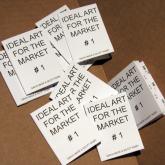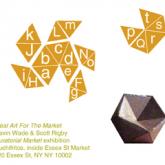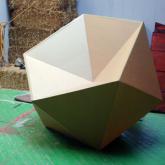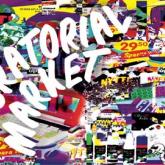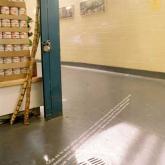I Deal Art For The Market
Exhibition press release
For immediate release:
Curatorial Market at Cuchifritos
September 7 - October 12
Private view Saturday September 7, 4-6 pm
Cuchifritos is proud to present ‘Curatorial Market’ a curatorial project devised by Swedish artist/curator Per Hüttner.
The work in the exhibition will be on display within and between Cuchifritos and the Essex St. Food Market. By moving the market into the gallery and the gallery into the market the project raises issues about what happens when borders are erased between artist and curator; art objects and commodities; gallery, shop and market. Curatorial Market is an experimental curatorial project, the fourth in Hüttner’s series Curatorial Mutiny the last of which showed at Nylon Gallery, London in collaboration with Gavin Wade and Goshka Macuga. The fourth show brings together 11 internationally acclaimed artist/curators who all work at the cutting edge of redefining what curation and artistic practise can and should be.
Contemporary food markets offer visual, olfactory, cultural and culinary temptations/meetings from all over the world. Curatorial Market offers in a similar fashion an artistic smorgasbord where individual artistic projects overlap with curatorial endeavours to extend discussion on how consumer culture affects art and vice versa.
Curatorial Market is a collaboration between Per Hüttner and the following artists/curators:
Claire Canning - Barnaby Drabble - Grady Gerbracht - Tone Hansen - Tone O Nielsen - Patrick Bernier - Cesare PietroIusti - Max Presneill - Reid Shier - Gavin Wade
Work on display by the following artists:
Ross Sinclair - Giancarlo Norese - Richard Allalouf & Andy Cox - Arni Gudmundsson - Franco Angeloni - Marius Engh - Joan Jonas - Ellen Harvey - Ayreen Anastas - William Gerbracht - Mark Alan Stamaty - Joseph Krupczynski - Justin Spivey - Kevin Schmidt - Ludovic Burel - Rainer Ganahl - Claire Canning - Grady Gerbracht - Tone Hansen - Per Hüttner - Tone O Nielsen - Patrick Bernier - Cesare PietroIusti - Max Presneill - Reid Shier - Gavin Wade & Scott Rigby - Måns Malmborg.
For more information about the project contact:
Per Hüttner: pah@swipnet.se
or
Paul Clay at Cuchifritos: info@mail.fictive.net
CUCHIFRITOS and inside the Essex St. Food Market
120 Essex Street
New York, NY 10002
btwn Delancey and Rivington.
(Inside the Essex St. Food Market at south end of building)
Open Monday through Saturday, 12:00 noon to 5:30pm.
www.artistsai.org/cuchifritos
Exhibition review
A Tasty Treat
By James Westcott
Zing Magazine 2002
According to the work “Border NY Times 01-02” at Cuchifritos gallery in Essex Street Market, the word “Border” appeared in New York Times headlines 124 times between January 2001 and September 2002. The artist/compiler Burel simply printed out all the stories and bound them together in a book. Almost every article is about fighting over borders, strengthening borders, or panicking at the porousness of borders.
Essex Street Market, an indoor shopping centre on the shabby Lower East Side, is not the kind of place you would expect to find an art gallery. But this is precisely the point. Cuchifritos, a tiny triangular space tucked away in the southern corner of the market, was created in August 2001 by the Artist’s Alliance Incorporated. They persuaded the New York City Economic Development Corporation, who owns the market, to give them $12,000 to renovate the space. The current exhibition, in which “Border…” appears, is called Curatorial Market. It is the culmination of the Cuchifritos project to dissolve boundaries between art and the market (literally, since the exhibition spills out into the market itself) and between Artists and the Market (for the exhibition, curators were invited to contribute as artists, and artists were asked to curate). Cuchifritos means something like a fried tasty treat.
Essex Street Market is an air-conditioned retreat from the street. Inside, there is a gentle happy hum of people. The market is lego-bright: shiny banners hang from the ceiling, the floor is blue; there are yellow pipes, red garbage cans, the green plastic fur of fake grass. There are electronics and clothes stores; you can get any part of any animal from Luis the butcher; there is a stall with 1970s kitsch objects and ethnic statues, with a sign saying “NO PHOTOGRAPHS”. Among the shoppers, a man is asleep draped over a table, a few old men gather around a television, people argue and joke; a man is dancing by himself. Beneath his feet is a question stuck to the ground in vinyl, translated into three languages: “What is it that you need or could make the market more ideal for you?”
The question is posed by the artists Gavin Wade and Scott Rigby, who are determined to make art useful, to make it solve problems. A cardboard structure sits in an empty stall, acting both as a sculptural interpretation of the produce boxes piled behind the counters everywhere and as a plinth upon which to place their pamphlet “An Ideal Art For the Market”. In it they ask two further questions, in five languages: “Ideally, how do you imagine art could be made of use to you?” and “What is your ideal relationship or connection to others in the market?”
Luis Rodriguez, the owner of Luis Meat Market, says he isn’t the kind of person who goes to galleries – not even Cuchifritos. But he was happy to answer Wade and Rigby’s questions. “Art is personal,” he wrote. “It has to be something that a person likes and enjoys, and somehow helps them to relax, and also I think that it could help to develop more business, for example if people see a work of art they become content, and when people are happy they have the tendency to spend more. For that reason I think that art is useful.” Rodriguez may be indifferent towards Cuchifritos but he understands the Curatorial Market idea perfectly: allowing art and commerce to embrace. He also insists that music should be piped into the market, to pacify people and get them to buy more. “This is the kind of music they should play – or jazz,” he says, smiling, and leaning back from the counter to turn up the radio.
Although he is not against the gallery, Rodriguez doesn’t understand why it is in the market. He asks me to explain the message behind it, when I was hoping he would explain it to me. I say something about making art accessible and bringing different kinds of people together. His deeply wrinkled, indented face scrunches up a little more. “There’s a big cultural difference between the people who come to the gallery and the housewives who come here to shop,” he says. “The people who go to the gallery are totally different, more educated.” Those who come here for the gallery don’t usually shop, and those who come here to shop don’t usually go the gallery, he explains. “So maybe the gallery isn’t really attracting either group of people in any great numbers.” Most shoppers seem to ignore Cuchifritos, but very occasionally someone stands transfixed by a photograph; one women exclaims “I love that idea!” And sometimes the “educated” people buy a nectarine or a peach from Farm Foods. Cuchifritos facilitates slippage between the categories of people in Essex Street Market through chance conversations and the surprise – even the affront – of finding art here. The kind of gentrification which Cuchifritos represents is more inclusive and inspiring than the standard process.
Rodriguez has mixed feelings about gentrification: he used to have a shop on the Lower East Side but was forced out when the rent went up from $500 to $4000 overnight. “All of a sudden a lot of boutiques started opening up and the area became…” he pauses, shrugs, “…hip.” On the other hand, he says the Lower East Side has improved dramatically in his lifetime, and Essex Street Market is indicative of the economic growth. “I am lucky to be in this market because everywhere else around here the rent is astronomical. I am very happy here. I hope nobody takes this market away from us.”
Although it is a symptom of gentrification, the Cuchifritos phenomenon is not simply a case of the East Village extending its tentacles of trendiness down to the Lower East Side, infiltrating and perhaps romanticizing an audience of cool uncultivated multiculturals. To think so would be snobbery dressed up as anti-snobbery: many of the market-goers and stall-owners are genuinely interested in art – why shouldn’t they be? – and have contributed to the last three exhibitions here.
For the August exhibition, “Local”, curatorship was democratized: everyone who works in the market was asked to bring in something from their home which they considered to be art. It could be something they had made themselves or something that had been made for them, something they found… anything they considered to be of artistic value.
Carmen Salvadore, who has run Three Brother’s Garments for twelve years, made a doll out of toilet paper for “Local”. “I am very grateful for the gallery coming here,” she says, “because I am a creative person and nobody would recognize that before. I don’t go to other galleries in the city, I have to admit. Cuchifritos is the only gallery I go to.” Carmen says that Cuchifritos brings “totally different” people to the market and that it has “opened the door” for her to meet new people. She beckons me over to see Wade and Rigby’s geodesic cardboard structure, before I can explain that I’ve already seen it. But she sees something I didn’t see: the masking tape is coming away at the side and the shape is bursting open. Carmen looks worried, strokes the wound in the sculpture and pushes it further back into the empty stall to protect it from passing people.
*
Paul Clay, the director of the Artist’s Alliance Incorporated (AAI) and the man who pitched the idea of Cuchifritos, is ecstatic to have given art to the people in the market as a part of their daily experience. “A totally unexpected thing which came out of the ‘Local’ project was the number of people who said that they do make art, but they just don’t have enough time to do it as much as they would like to, if at all. I thought that was both amazing and tragic – an example of how work just eats away at life and closes so many opportunities.”
These opportunities are something the AAI wants to give back, not only through Cuchifritos. The AAI formed in 1998 and is based in a derelict school building on Suffolk Street, two blocks behind the market. It is now the largest long-term studio program in Manhattan, with sixty-five artists in residence. As well as a way to organise and galvanise its members, the AAI has always been focussed on disseminating art into the community. In the summer the AAI holds an outdoor event called SPLASH! where children paint anything they want on a huge canvas. “It’s a lot of fun,” says Clay, “and with Cuchifritos we’re giving a little taste of art for people in the market.”
But Clay is cautious about the issue of gentrification and the imposition, the assumptions and the awkward questions of class and snobbery it raises, especially in the realm of art: “At first we weren’t even sure if we should pitch the idea [to the EDC], because we didn’t want to go in there and gentrify the market. Then a nice lounge and restaurant took up residency at the north end of the building. At that point we felt the addition of our space wasn’t a problem in comparison.”
The AAI has had bitter experience of gentrification, having nearly been evicted from their studios. The city wanted to sell the building and the organization which manages the building also wanted them out. “But we’re now working with the city and with theater groups and resident organizations to set up an entirely new not-for-profit to manage the maintenance of the building and to raise funds for capital improvement. It will take on the bricks and mortar stuff, leaving AAI free to run the studio program and other activities.” The building needs millions of dollars worth of renovations: for a visitor its dank decay may be charming but to work there must be difficult. “Rents are subsidized to make affordable workspace,” Clay explains, “but the work that goes into defending the place and sustaining it is phenomenal.”
Clay is still optimistic about gentrification: “The critical thing New York needs right now is neighborhood development strategies. No one is going to stop gentrification, but the engine of development can be harnessed to benefit the local people in a community, by diffusing profit into the neighborhood, rather than funneling it all to outsiders at the top and forcing local people out.”
*
Despite its populist ideals, the Curatorial Market raises complex, insider issues about the relationship between artist and curator. “These two disciplines are beginning to mix and merge in ways that some people find appalling and others see as a powerful new development in the history of art making,” Clay explains. However, abandoning the idea of the autonomous piece of art can be problematic. “Having art that relates very strongly to the market context can fuck up the commodification process in an interesting way. It both points it up as an object to consume, and at the same time makes it harder to effectively remove from its context in order to be sold. There is a danger that when curators have too strong an over-arching vision that the artists’ works can end up simply as building blocks used to construct the curator’s point. On the other hand if the curator’s point is weak then the works can get stranded totally out of context.”
Per Hüttner, the director of Curatorial Market, dodged these problems simply by opening up the curatorial process. A photographer and video artist as well as a curator, he believes in a symbiotic relationship between art, curator, and context. “Curating is very much connected to art in general,” he says. “It’s a means of expressing myself just as creatively as I do in art. I don’t see much difference between the two.”
Hüttner took his first “stumbling steps” in curating in a gallery in Stockholm, called Konstakuten, which he opened with three colleagues in 1995. Curating was necessary both as a way of erasing traditional boundaries in the gallery and as a means of “self preservation”: “We weren’t interested in just showing art to our mates,” says Hüttner. “Without a stimulating environment and dynamic peer group any artist, however talented and motivated, will eventually fall silent. This either means that the artist stops developing or simply stops working altogether.” Above all, artists need a challenging community for support and inspiration. “That’s why I picked up curating, because it offered me tools to grow as an artist and human being – through meeting people.”
“When I first started this project my idea was to bring over my favorite people in the art world. But when I saw the gallery I realized that the context of it was something that needed to be addressed.”
The work that most beautifully addresses the context of trade is the sound installation by Tank magazine arts editor Claire Canning, Andy Cox (the former guitarist in the Beat and the Fine Young Cannibals) and producer Richard Allalouf. It is an eavesdropping recording of bleeps at a supermarket checkout set against the muted chattering of parents packing their shopping and the excited giggling of their children. Occasionally the notes of the bleeps are made to echo and soar; all the while there is a strange, barely audible rumbling – the sound of process, of things working.
Like Wade and Rigby, Hüttner is for immediacy and usefulness in art. “Art is by default, in the western context, useless. The fact that no one can walk into the Met and use the Melanesian masks for a private ritual in the museum proves that point. It’s all about context.” Hüttner wishes that the idea of the autonomous work of art was obsolete. However: “The network between collectors, museums and traditional curators does nothing to challenge the social and monetary systems within the art world.” For them to work against the networks by undermining the self-sufficiency of the art work “would be like biting the hand that feeds them. But then again anyone who wants to challenge and change things will ultimately become that renegade canine that bites his owner.”
In the Curatorial Market, Hüttner insists that he doesn’t have an agenda, just some questions: “To what degree is art about ideas and to what degree is it about objects? How is commodification and the fetishization of commodities reflected in contemporary art? Was art a forerunner of this fetishism? What benefits and pitfalls are there for contemporary art when art is no longer object based?”
Hüttner acknowledges that, since all the works were chosen with the market in mind, should the Curatorial Market go on tour, it would have to change completely. But it is this transience, this uniqueness that is the attraction of the project. “It was such a nice atmosphere setting up the exhibition in the market,” Hüttner says. “A gallery or a museum can be quite hostile. Working in the market I felt that every day there were magical meetings between people, who would not normally interact – because of the social void which is created in the process of gentrification. The art in Cuchifritos reaches out to the people who are not normally exposed to it, and we have the possibility of experiencing a social context that we wouldn’t normally be able to take part in. As soon as the process of gentrification stops and everyone – on both sides – gets stuck in their ways, this exchange will wither and die. So, yes, I think the gallery does speed up the process of gentrification, but at the same time it also creates opportunities within this process that are a lot more valuable than we could ever imagine.”

